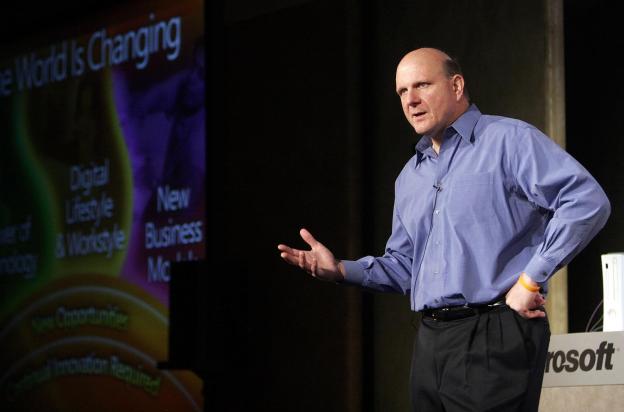
Steve Ballmer took the wraps off a mammoth reorganization of Microsoft this week, outlining a new “One Microsoft” structure (and then outlining it again) based on a small number of functional groups rather than a large number of product groups. The basic idea is simple: get product teams and technologies that depend on each other together so they can work more efficiently towards Microsoft’s vision of being a one “devices and services” company.
Microsoft’s new structure looks like a paean to Apple, which famously reorganized around functional groups rather than products when Steve Jobs returned to the fold in the late 1990s. But Microsoft’s business is fundamentally different from Apple’s – and orders of magnitude larger than Apple was when it re-organized at the nadir of its fortunes. Will Microsoft’s new structure produce a nimbler company that can lead technology trends rather than follow them? Can “One Microsoft” be able to make cool stuff people actually want? Or – with almost 100,000 employees worldwide – is Microsoft’s business simply too big to turn around?
Who cares how Microsoft is organized, anyway?
We know: corporate organization is pretty boring stuff. If you’ve ever worked a company job, your first on-the-clock nap was probably at a mandatory meeting with executives monotonously clicking through slides filled with boxes, arrows, and lines. Instant snooze.

In some ways, this served Microsoft well: Windows, Office, and Exchange each dominate their industries. Microsoft also successfully built its Xbox business largely by keeping it (and its culture) separate. Further, many a Microsoft employee has found working on smaller products rewarding: they’re on tight, fast-moving, motivated teams doing new work, not cogs in a corporate giant.
One could argue that Microsoft’s strategy is the opposite of Apple’s
Another danger is fiefdoms. Inevitably, lean-and-mean product teams develop a sense of pride and compete with each other. That can make for better products in the long run, but some products are always more important than others. For instance, Microsoft sunk hundreds of millions into developing tablets a dozen years ago, only to have its Office VP essentially torpedo the idea because he thought styluses were non-starters. That’s why using Office on old-school Windows tablets and convertibles sucked. (But yes: styluses probably had something to with it too.)
A third problem is that, at Microsoft, Windows always wins – and that was especially true under the now-departed Steve Sinofsky, who headed up Windows 8 and Surface. Everyone needed Windows, but Windows didn’t need everyone else, so Sinofsky basically played hardball until he got what he wanted. Remember the never-born Courier tablet? What about Danger and the quickly-killed Kin pseudo-smartphones? Both casualties of going up against what would eventually become Windows Phone and Windows RT. Another clash with Windows was partly responsible for cloud computing lead Ray Ozzie leaving the company, and even current Nokia CEO Stephen Elop left his gig as head of Microsoft’s business software division in part due to conflicts with the Windows juggernaut.
OK, but someone has to be in charge, right?
These conflicts make sense, but they also seem unavoidable. Someone has to be in charge of a product, right?
Not necessarily – and Microsoft’s new structure reflects that. Instead of organizing by product team, Microsoft’s development efforts will fall into four main groups. The idea is to break down Microsoft’s product efforts into functional areas so specific people or teams actually responsible for a given function or feature are the only ones working on it – they know it best! – and major decision-making happens towards top of the company hierarchy. In functional organizations, each group only has people who work in its area. A marketing group would just be marketers, it wouldn’t also have its own separate IT department.

As an example, the team working on the next Surface device will have people from the operating system, devices, services, and cloud groups (at least!), ensuring that not only are all those groups talking to each other about Surface, but that no individual team has a stranglehold on others.
And, yes: I’ve simplified. There are other groups like marketing, research and development, business development and evangelism, finance, legal, and more. There’s even one pure product fiefdom left: Dynamics, basically the business management and customer relationship businesses Microsoft’s acquired over the years.
Isn’t this like Apple?
Critics have noted a functional organization is like Apple. In some ways, that’s disingenuous: the details of Apple’s corporate structure are closely guarded, and even long-time employees don’t know much about how Apple is organized. Steve Jobs famously characterized Apple as “the biggest startup on the planet.”
But there are parallels. For instance, Apple does not have a Macintosh division, an iPad division, or even an iPhone division. Instead, product responsibilities are spread horizontally across several roles, including design (Jonathan Ive), hardware engineering (Dan Riccio), software engineering (Craig Federighi), Internet software (Eddie Cue), and technology (Bob Mansfield). The iPhone and the iPad might be driving the company’s bottom line, but neither of them has an executive-level boss. Apple doesn’t even have a head of devices – an odd situation for a hardware company.
Microsoft is taking a page from this book: most products will be driven by teams that span its major groups. There is no Xbox or entertainment group, there is no Office group – heck, Microsoft isn’t even making much of an organizational distinction between consumer and enterprise. There’s not even a Windows group! Sounds like Apple, right?
Apple doesn’t even have a head of devices – an odd situation for a hardware company.
Apple may be one of the most valuable companies on the planet, but functional organization was born when it was teetering on the edge of bankruptcy and was ready to accept tremendous change in order to survive. Steve Jobs returned in 1997 with that kind of change, radically re-aligning Apple while jettisoning just about everything he felt was inessential. And Apple has very few products for a major company.
Today, Microsoft is not in the kind of trouble Apple was facing in 1997. So, its reorganization is nowhere near as radical (nothing has been jettisoned), and its line of products and services is much larger. Microsoft’s reorganization is not designed to save the company: it is designed to make it operate more efficiently and (therefore) earn more profit.
Follow the money

One thing these business have in common is that their most important customers are volume licensers (like computer makers, enterprise, schools, and governments), not individual consumers. Yes, Microsoft has other businesses, and some are even consumer-focused. Microsoft runs the number-two Internet search engine, has its own gaming empire (Halo, anyone?), and runs some of the world’s most-used Internet services like Outlook.com and Skype, and has its own games/music/video/software store. But right now, those things aren’t major contributors to Microsoft’s bottom line. (In fact, collectively, they’re a drain.)
Microsoft’s biggest money comes from its biggest customers, and Microsoft’s reorganization is mainly about keeping those customers on board and happy. This is plainly evident in the emphasis Ballmer places on applying technology to meetings and decision-making, describing them as “time-intensive, high-value scenarios that are ripe for digital re-imagination.” To do that, Ballmer calls out Bing, Excel, and InfoNav (an in-development natural language query engine – think Siri) as key technologies to help with decisions and tasks. Ballmer says “we have focused not only on what matters most to individuals but also on what’s vital to businesses around the globe.” But right now, the corporate customers are the ones who are buying. Outside of Xbox, Microsoft’s success with consumers has been very limited.
Will Microsoft get cooler?
Microsoft has famously missed the boat on key technology developments of the last two decades. It didn’t anticipate the rise of the Internet; it was very late to personal media players (remember Zune?); failed several times in digital media; got to the Internet search game late; whiffed on blogging, social networking, and sharing; took a $6.2 billion writedown on its online marketing business; and it’s now very late to smartphones and tablets (now discounted!).
This doesn’t mean Microsoft is incapable of producing technological innovations that will change the industry. However, despite breaking down most of the formal lines separating its consumer and enterprise businesses, Microsoft’s eyes are still going to be on its own bottom line. For now, that means enterprise, and the company’s “one Microsoft” vision is mainly about making it easy for those enterprise customers to continue using Microsoft technology, in Ballmer’s words, “after hours.”
In fact, one could argue Microsoft’s strategy is the opposite of Apple’s. Apple’s recent successes in the workplace and enterprise has largely come from customers using their iPhones and iPads to work whether employers liked it or not. Microsoft is effectively trying the reverse: hoping enterprise users will take Microsoft products home with them. For some customers – particularly those who live in meetings and are “tasked” with “decision-making” – that might be a no-brainer. For others, it’ll be an uphill battle.


